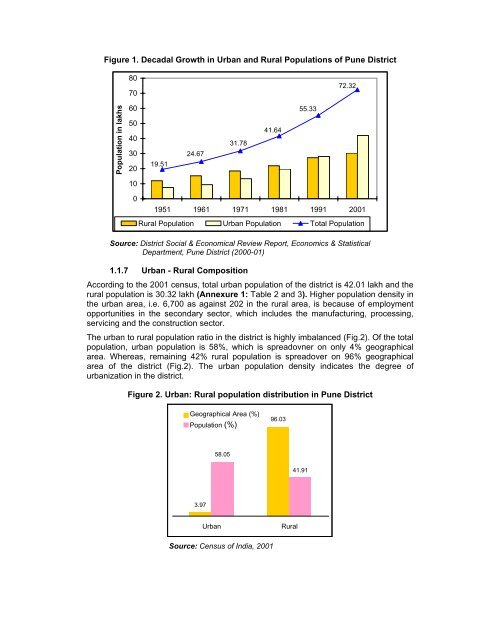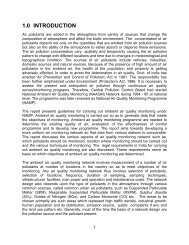Chapter 1 GENERAL FEATURES OF PUNE DISTRICT
Chapter 1 GENERAL FEATURES OF PUNE DISTRICT
Chapter 1 GENERAL FEATURES OF PUNE DISTRICT
Create successful ePaper yourself
Turn your PDF publications into a flip-book with our unique Google optimized e-Paper software.
Figure 1. Decadal Growth in Urban and Rural Populations of Pune District<br />
Population in lakhs<br />
80<br />
70<br />
60<br />
50<br />
40<br />
30<br />
20<br />
10<br />
0<br />
19.51<br />
24.67<br />
31.78<br />
41.64<br />
55.33<br />
72.32<br />
1951 1961 1971 1981 1991 2001<br />
Rural Population Urban Population Total Population<br />
Source: District Social & Economical Review Report, Economics & Statistical<br />
Department, Pune District (2000-01)<br />
1.1.7 Urban - Rural Composition<br />
According to the 2001 census, total urban population of the district is 42.01 lakh and the<br />
rural population is 30.32 lakh (Annexure 1: Table 2 and 3). Higher population density in<br />
the urban area, i.e. 6,700 as against 202 in the rural area, is because of employment<br />
opportunities in the secondary sector, which includes the manufacturing, processing,<br />
servicing and the construction sector.<br />
The urban to rural population ratio in the district is highly imbalanced (Fig.2). Of the total<br />
population, urban population is 58%, which is spreadovner on only 4% geographical<br />
area. Whereas, remaining 42% rural population is spreadover on 96% geographical<br />
area of the district (Fig.2). The urban population density indicates the degree of<br />
urbanization in the district.<br />
Figure 2. Urban: Rural population distribution in Pune District<br />
Geographical Area (%)<br />
Population (%)<br />
3.97<br />
58.05<br />
Source: Census of India, 2001<br />
96.03<br />
Urban Rural<br />
41.91

















